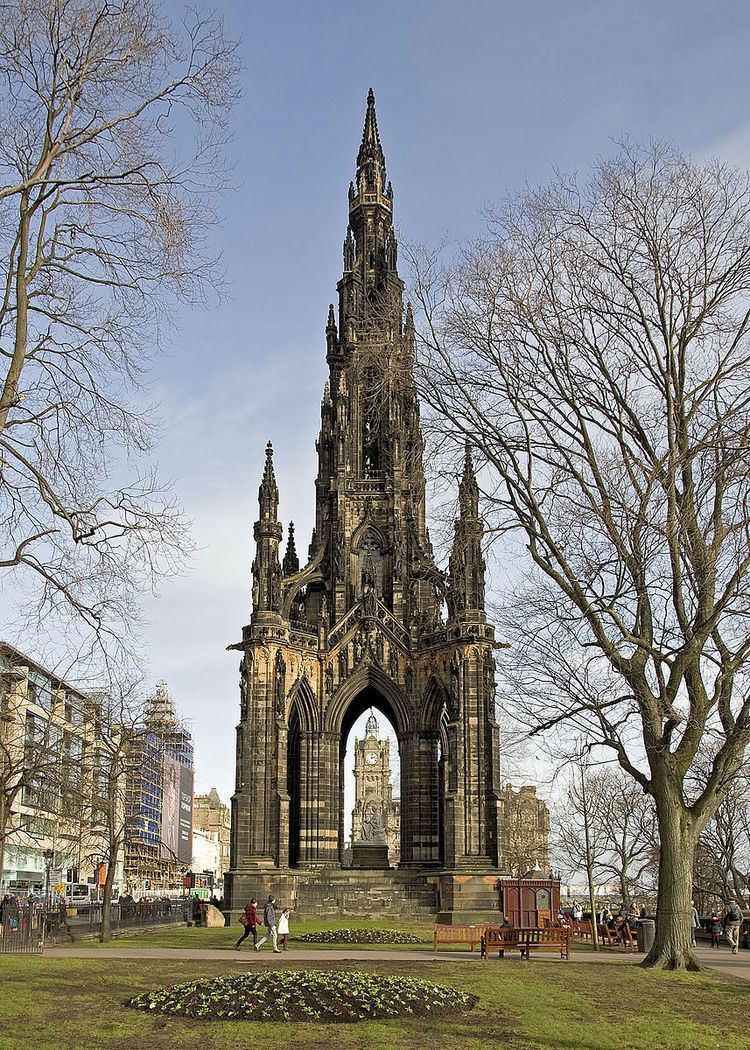Height 60 m Opened 1844 | Construction started 1840 Phone +44 131 529 4068 | |
 | ||
Architectural style Gothic Revival architecture Similar Princes Street Gardens, St Giles' Cathedral, Calton Hill, Holyrood Palace, Arthur's Seat | ||
Climbing the scott monument edinburgh scotland 4 10 12
The Scott Monument is a Victorian Gothic monument to Scottish author Sir Walter Scott. It is the largest monument to a writer in the world. It stands in Princes Street Gardens in Edinburgh, opposite the Jenners department store on Princes Street and near to Edinburgh Waverley Railway Station, which is named after Scott's Waverley novels.
Contents
- Climbing the scott monument edinburgh scotland 4 10 12
- Scott monument edinburgh
- Design and Concept
- History
- Statues and locations
- Modern administration
- In popular culture
- References
Scott monument edinburgh
Design and Concept
The tower is 200 feet 6 inches (61.11 m) high, and has a series of viewing platforms reached by a series of narrow spiral staircases giving panoramic views of central Edinburgh and its surroundings. The highest platform is reached by a total of 287 steps. It is built from Binny sandstone quarried near Ecclesmachan in West Lothian.
In terms of its location, it is placed on axis with South St David Street, the main street leading off St Andrew Square to Princes Street, and is a focal point within that vista, its scale being large enough to totally screen the Old Town behind. As seen from the south side, Princes Street Gardens, its location appears more random, but it totally dominates the Eastern Section of the gardens, through a combination of its scale and elevated position relative to the sunken gardens.
History
Following Scott's death in 1832, a competition was held to design a monument to him. An unlikely entrant went under the pseudonym "John Morvo", the name of the medieval architect of Melrose Abbey. Morvo was in fact George Meikle Kemp, forty-five-year-old joiner, draftsman, and self-taught architect. Kemp had feared his lack of architectural qualifications and reputation would disqualify him, but his design (similar to an unsuccessful one he had earlier submitted for Glasgow Cathedral) was popular with the competition's judges, and in 1838 Kemp was awarded the contract to construct the monument.
John Steell was commissioned to design a monumental statue of Scott to rest in the space between the tower's four columns. Steell's statue, made from white Carrara marble, shows Scott seated, resting from writing one of his works with a quill pen and his dog Maida by his side. The monument carries 64 figures (carried out in three phases) of characters from Scott's novels by a variety of Scots sculptors including, Alexander Handyside Ritchie, John Rhind, William Birnie Rhind, William Brodie, William Grant Stevenson, David Watson Stevenson, John Hutchison, George Anderson Lawson, Thomas Stuart Burnett, William Shirreffs, Andrew Currie, George Clark Stanton, Peter Slater, and two female representatives, Amelia Robertson Hill (who also made the statue of David Livingstone immediately east of the monument), who contributed three figures to the monument, and the otherwise unknown Katherine Anne Fraser Tytler.
The foundation stone was laid on 15 August 1840. Following permission by an Act of Parliament (the Monument to Sir Walter Scott Act 1841 (4 & 5 Vict.) C A P. XV.), construction began in 1841 and ran for nearly four years. The tower was completed in the autumn of 1844, with Kemp's son placing the finial in August of the year. The total cost was just over £16,154. When the monument was inaugurated on 15 August 1846, George Meikle Kemp himself was absent, having fallen into the Union Canal while walking home from the site on the foggy evening of 6 March 1844 and drowned.
Statues and locations
See
In total (excluding Scott and his dog) there are 68 figurative statues on the monument of which 64 are visible from the ground. Four figures are placed above the final viewing gallery and are only visible by telephoto or (at a very distorted angle) from the viewing gallery itself. In addition, eight kneeling Druid figures support the final viewing gallery. There are 32 unfilled niches at higher level.
Sixteen heads of Scottish poets and writers appear on the lower faces, at the top of the lower pilasters. The heads (anti-clockwise from the NW) represent: James Hogg; Robert Burns; Robert Fergusson; Allan Ramsay; George Buchanan; Sir David Lindsay; Robert Tannahill; Lord Byron; Tobias Smollett; James Beattie; James Thomson; John Home; Mary, Queen of Scots; King James I of Scotland; King James V of Scotland; and William Drummond of Hawthornden.
In total, 93 persons are depicted, plus two dogs and a pig.
(S) represents a small figure
Modern administration
In the early 1990s it was proposed that the stonework should be cleaned. There were views for and against cleaning and a scientific/geological investigation, including cleaning trials on samples of stone, was carried out. It was decided not to clean the stone due to the damage it would sustain. A restoration programme was undertaken involving replacing old repairs and damaged areas with Binny stone for which purpose the original quarry was re-opened. The fresh stonework contrasts with the smoke-darkened original.
The overall cost of the restoration was £2.36 million and was funded by the Heritage Lottery Fund, Historic Scotland and the City of Edinburgh Council.
The monument is now administered by the Culture and Sport division of the City of Edinburgh Council. (See External Links for visitor information.)
A new LED lighting system was installed on the monument in 2016, illuminated for the first time on 21 September, which is "intended to highlight the monument’s architectural features with a soft warm glow".
In popular culture
The monument is featured prominently in the movie Cloud Atlas, as a location which the character Robert Frobisher frequents.
